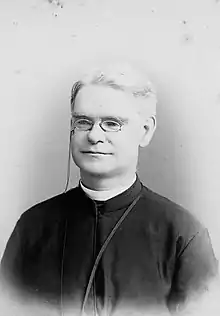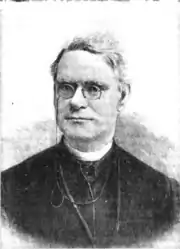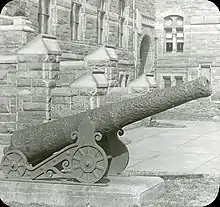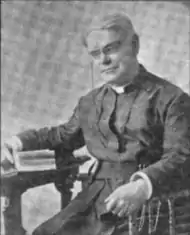James A. Doonan
James Aloysius Doonan, S.J. (November 8, 1841 – April 12, 1911) was an American Catholic priest and Jesuit who was the president of Georgetown University from 1882 to 1888, during which time he oversaw the naming of Gaston Hall and the construction of a new building for the School of Medicine. He also acquired two historic cannons that were placed in front of Healy Hall. Doonan was a financially successful president, reducing the university's burdensome debt that had accrued during the construction of Healy Hall.
James A. Doonan | |
|---|---|
 Doonan in 1890 | |
| 30th President of Georgetown University | |
| In office 1882–1888 | |
| Preceded by | Patrick Francis Healy |
| Succeeded by | J. Havens Richards |
| Personal details | |
| Born | November 8, 1841 Augusta, Georgia, U.S. |
| Died | April 12, 1911 (aged 69) Washington, D.C., U.S. |
| Resting place | Jesuit Community Cemetery |
| Alma mater | |
| Orders | |
| Ordination | 1874 by James Gibbons |
Prior to his administration of Georgetown, he was a student there and at Woodstock College. He then taught at Loyola College in Maryland and Boston College. He spent his later years teaching and ministering at Boston College and at Saint Joseph's College in Philadelphia, as well as at St. Francis Xavier College in New York and at the Catholic Summer School of America.
Early life
James Aloysius Doonan was born on November 8, 1841, in Augusta, Georgia.[1] He was the son of Ellen Doonan (née Barry) and Terrence Doonan, an engineer and wealthy railroad official and one of the first Catholics in Atlanta. Terrence was entrusted by the local priest with keeping the parish records until a pastor was appointed, and in his home, the first Catholic baptism in Atlanta was performed.[2]

Doonan enrolled at Georgetown University in Washington, D.C., in 1853, and then entered the Jesuit novitiate at Frederick, Maryland, in July 1857.[1] Doonan's brother, John, also became a Jesuit priest.[2] After four years, James completed his classical course of study,[1] during which he was the captain of the student cadet regiment.[3] He then went to teach at Loyola College in Baltimore in 1861, where he remained for three years, during the Civil War. James Doonan was said to frequently recount a story of the time he was present at a High Mass in Baltimore, when word of the approaching Union Army caused the congregants to leave and take up arms. As a staunch supporter of the Confederacy, he was aggrieved at being forced by the Union Army to bear arms on their behalf and act as a sentinel for several hours.[4]
In 1864, he was sent to Boston College to teach for three years,[5] after which he returned to Washington, where he went to Georgetown to study philosophy. His studies were paused in 1868 while he taught for a year at Georgetown,[3] and he then resumed his philosophical studies at the newly established Woodstock College. Doonan was put in charge of the choir at Woodstock, and was noted for his skills on the violin and for his bass voice.[3] He was ordained a priest in 1874 by James Gibbons,[6] at the time the Bishop of Richmond,[7] and he completed his studies at Woodstock in 1875.[3]
Georgetown University

Doonan was appointed a professor of poetry at Georgetown in 1874. In September 1875, he went to Frederick, before returning to Georgetown in 1877 as a professor of rhetoric. He also served as vice president of the university and prefect of studies for a time.[8]
Upon Patrick Francis Healy's resignation of the presidency due to his declining health, Doonan became the acting president and vice rector on January 27, 1882.[1] On August 17 he became the president of Georgetown University.[8] In this position, he inherited a large debt, small student enrollment, and no endowment.[9] However, he continued to receive large donations that had been elicited during his predecessor's term of office; coupled with his sale of a villa in Tenleytown and a farm on Hickory Hill (near Glover Park) that were owned by the university, he was able to reduce the significant debt of more than $300,000,[10] which had accrued from the construction of Healy Hall.[11] Doonan redoubled his predecessor's fundraising efforts among the alumni of Georgetown. His efforts were praised by the Jesuit provincial superior, Thomas J. Campbell, and Doonan would eventually leave office with a greatly reduced debt.[12] At the commencement exercises of 1882, he distributed diplomas for the first time under the university's new federal charter.[13]

For several years, Doonan promoted the idea that a celebration of the university's centenary be organized,[9] which culminated in an official celebration in February 1889.[14] In anticipation of the occasion, Doonan purchased in 1885 two cannons from St. Inigoes, Maryland, for $50. It was believed that they were brought to America aboard the Ark, which along with the Dove carried the first settlers to the Province of Maryland. In fact, they had been a part of Lord Baltimore's expedition to St. Mary's County in 1634. Doonan had them placed in front of Healy Hall on November 1, 1888.[15] He also proposed that Healy Hall's main auditorium, which remained unfinished, be completed and named Gaston Memorial Hall after the school's first student, William Gaston.[14]
During Doonan's presidency, a new building was constructed for the School of Medicine,[16] which was designed by Paul J. Pelz and erected on the corner of 10th and E Streets in the summer of 1886.[17] In the following year, the Catholic University of America was established in Washington, leading to considerable tension between its founders and the Jesuits at Georgetown. Bishop John J. Keane, Catholic University's first rector,[18] attempted to resolve this dispute by unsuccessfully offering to purchase Georgetown University,[19] tendering this proposal to Doonan.[20]
His presidency came to an end in mid-August 1888, when he was sent by the Jesuit provincial superior to New York,[8] and was succeeded by Joseph Havens Richards.[12]
Later teaching
Doonan taught philosophy for a year at St. Francis Xavier College in New York, and then for a year in Detroit, Michigan. In 1891, he was sent to Boston College, followed by a time at Saint Joseph's College in Philadelphia, where he remained until 1896.[21] For at least part of his time at Saint Joseph's, he served as the university's chaplain.[22] He also lectured several times at the Catholic Summer School of America,[23] in such subjects as psychology and education.[24] At this time, Doonan's active ministry came to an end due to his failing eyesight. Fearing that he would become totally blind, he completed a pilgrimage to the Grotto of Our Lady of Lourdes in France; he never did lose his sight completely.[3]
Doonan then returned to Philadelphia, where he suffered a stroke, causing partial paralysis.[21] Nonetheless, he led the annual retreat for the priests of the Diocese of Rochester at Saint Bernard's Seminary in 1897.[25] In 1902, he was appointed the spiritual director of the Jesuit community at St. Joseph's College and the Church of the Gesú in Philadelphia, succeeding Burchard Villiger.[26] In 1906, he returned to Georgetown University, where he lived out the remainder of his life.[27] Despite his impaired condition, he continued to say Mass daily until one week before his death on April 12, 1911.[28] Doonan was buried in the Jesuit Community Cemetery at Georgetown.[29]
References
Citations
- Shea 1891, p. 285
- DeLorme, Rita H. (November 3, 2011). ""Catholicity is the same age as the city (Atlanta)": Msgr. Joseph E. Moylan" (PDF). The Southern Cross. Diocese of Savannah. p. 5. Archived from the original (PDF) on December 27, 2018. Retrieved December 27, 2018.
- Woodstock Letters 1911, p. 374
- Woodstock Letters 1911, pp. 373–374
- Easby-Smith 1907, p. 154
- Woodstock Letters 1916, p. 80
- Woodstock Letters 1916, p. 74
- Easby-Smith 1907, p. 155
- Curran 1990, p. 2
- Dwulet, Andrew (September 18, 2009). "A Campaign Unfinished". The Hoya. Archived from the original on December 15, 2018. Retrieved December 15, 2018.
- Shea 1891, p. 307
- Curran 1990, p. 3
- Shea 1891, p. 286
- Shea 1891, p. 305
- "Fact or Fiction? Mythbusting Hoya History with the University Archives". Georgetown University Library. August 23, 2016. Archived from the original on March 1, 2018. Retrieved October 30, 2018.
- Easby-Smith 1907, p. 148
- Shea 1891, p. 300
- Gorman 1991, p. 15
- Gorman 1991, p. 16
- Gorman 1991, p. 25
- Woodstock Letters 1911, p. 375
- Official Catholic Directory, Almanac and Clergy List 1905
- Mosher 1899, p. 196
- Mosher 1899, p. 183
- "News and Notes". The Sacred Heart Review. 18 (12): 234. September 18, 1897. Archived from the original on December 27, 2018. Retrieved December 27, 2018 – via Boston College Libraries.
- "Ecclesiastical Items". The Sacred Heart Review. 28 (22): 338. November 29, 1902. Archived from the original on December 27, 2018. Retrieved December 27, 2018 – via Boston College Libraries.
- Woodstock Letters 1911, p. 376
- Woodstock Letters 1911, pp. 375–376
- Maryland-New York Province 1912, p. 70
Sources
- Curran, R. Emmett (1990). "Georgetown's Self-Image at Its Centenary". In McFadden, William C. (ed.). Georgetown at Two Hundred: Faculty Reflections on the University's Future. Washington, D.C.: Georgetown University Press. pp. 1–17. ISBN 9780878405022. Archived from the original on December 15, 2018 – via Google Books.
- Easby-Smith, James Stanislaus (1907). Georgetown University in the District of Columbia, 1789-1907: Its Founders, Benefactors, Officers, Instructors and Alumni. 1. New York: Lewis Publishing Company. pp. 136–163. OCLC 633425041. Archived from the original on December 15, 2018 – via Google Books.
- Gorman, Vincent J. (Fall 1991). "Georgetown University: The Early Relationship with the Catholic University of America 1884—1907". Records of the American Catholic Historical Society of Philadelphia. 102 (3): 13–31. JSTOR 44211137.
- "List of Priests Ordained at Woodstock College (From 1870 to 1915.)" (PDF). Woodstock Letters. 45 (1): 74–85. February 1, 1916. Archived (PDF) from the original on January 10, 2021. Retrieved January 10, 2021 – via Jesuit Archives.
- Maryland-New York Province (1912). Catalogus Provinciae Marylandiae-Neo Eborancensis Societatis Jesu [Catalogue of the Province of Maryland-New York of the Society of Jesus] (PDF) (in Latin). Meany Printing Company. Archived (PDF) from the original on December 4, 2017. Retrieved January 3, 2019.
- Official Catholic Directory, Almanac and Clergy List for the Year of Our Lord 1905. 19. Milwaukee, Wisconsin: M. H. Wiltzius Company. 1905. OCLC 310933191. Archived from the original on January 13, 2019 – via Google Books.
- Mosher, Warren E. (May–September 1899). "Some of the Lecturers". Mosher's Magazine. 14: 185–197. Archived from the original on December 27, 2018 – via Google Books.
- "Obituary: Father James A. Doonan" (PDF). Woodstock Letters. 40 (3): 373–376. October 1, 1911. Archived (PDF) from the original on January 10, 2021. Retrieved January 10, 2021 – via Jesuit Archives.
- Shea, John Gilmary (1891). "Chapter XXIX: Father James Aloysius Doonan". Memorial of the First Century of Georgetown College, D. C.: Comprising a History of Georgetown University. 3. New York: P. F. Collier. pp. 285–309. OCLC 612832863. Archived from the original on December 15, 2018 – via Google Books.
External links
| Wikimedia Commons has media related to James A. Doonan. |
| Academic offices | ||
|---|---|---|
| Preceded by Patrick Francis Healy |
30th President of Georgetown University 1882—1888 |
Succeeded by J. Havens Richards |